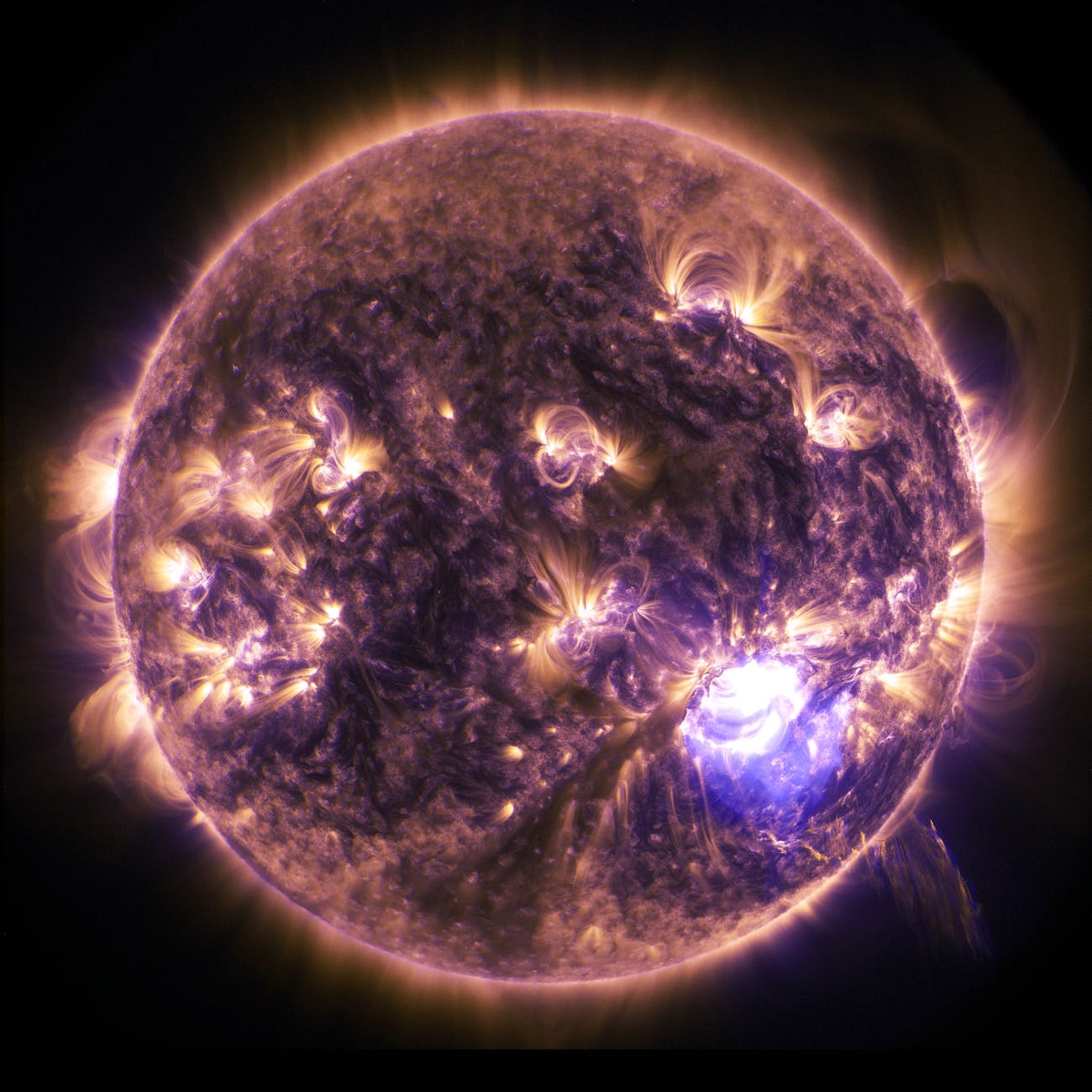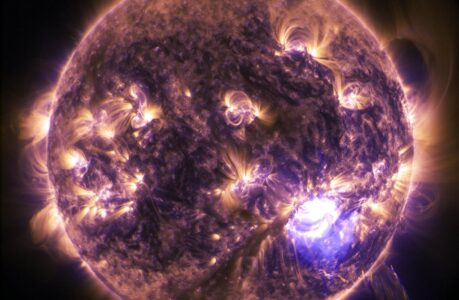The universe is a tapestry of celestial wonders, and our very own star, the Sun, holds mysteries that continue to intrigue scientists and stargazers alike. Among its most breathtaking phenomena are solar flares, immense eruptions of energy that unleash the Sun’s fiery power into the cosmos. In this article, we delve into the captivating world of solar flares, exploring their causes, characteristics, and potential impacts on our planet.
1. Unveiling the Sun’s Fiery Arsenal
The Sun, a colossal ball of superheated plasma, is a thermonuclear powerhouse that constantly churns and releases energy. Deep within its core, nuclear fusion reactions take place, converting hydrogen into helium and releasing an enormous amount of energy in the process. This energy radiates outward from the core, eventually reaching the Sun’s surface, known as the photosphere.
Beneath the seemingly calm surface lies an intricate and turbulent layer called the chromosphere. It is in this region that solar flares find their origin. The chromosphere, with its intense magnetic fields and swirling plasma, acts as a breeding ground for the immense forces that drive these explosive events.
2. Ignition: The Birth of a Solar Flare
The intricate dance of magnetic fields within the Sun’s chromosphere plays a crucial role in the formation of solar flares. These magnetic fields can become twisted and contorted, creating regions of intense stress and tension. When the pressure becomes too great, the magnetic field lines break and reconnect, releasing a tremendous amount of energy.
The precise mechanisms behind this process are still not fully understood, but scientists believe that the interaction between plasma and magnetic fields is the key. As the magnetic field lines reconnect, they accelerate charged particles, such as electrons and protons, to incredible speeds. This energized particle soup, known as a plasma, becomes the fuel for the impending solar flare.
3. Unleashing the Fury: The Anatomy of a Solar Flare
A solar flare begins with a precursor event called a pre-flare. During this stage, energy builds up within the Sun’s magnetic fields, gradually intensifying the magnetic stress. Observations of pre-flares often reveal the formation of bright arcs and loops along the Sun’s surface, indicating the build-up of energy.
When the magnetic stress reaches its breaking point, the pre-flare stage gives way to the main event—the solar flare itself. In an instant, an eruption occurs, unleashing a torrent of energy and particles into space. The energy released during a solar flare is mind-boggling, equivalent to the detonation of millions of hydrogen bombs simultaneously.
The energy emitted during a solar flare spans the entire electromagnetic spectrum, from radio waves to X-rays and even gamma rays. This diverse range of radiation provides valuable insights into the physical processes at work within the flare. Using specialized instruments and telescopes, scientists are able to observe and analyze the various components of solar flares, unraveling their mysteries.
4. The Colors of Chaos: Understanding Solar Flare Classification
Solar flares exhibit a wide range of characteristics, and scientists have devised a classification system to categorize their strength and intensity. The most commonly used classification scheme is the X-ray classification, which is based on the intensity of X-ray emissions from the flare.
The X-ray classification consists of five categories: A, B, C, M, and X. Each category is divided into subcategories, allowing for a more precise assessment of flare strength. For example, an X2 flare is twice as powerful as an X1 flare, and an X3 flare is three times more powerful.
Solar flares classified as C-class are considered minor, with little to no impact on Earth. M-class flares are moderate in strength and can cause brief radio blackouts in the polar regions. However, it is the X-class flares that demand our utmost attention. These powerful eruptions have the potential to disrupt satellite communications, damage power grids, and even pose a risk to astronauts in space.
5. Dancing Lights: The Spectacular Aurora
One of the most captivating displays resulting from solar flares is the aurora borealis (northern lights) and aurora australis (southern lights). These ethereal, luminescent curtains of light grace the night skies near the Earth’s polar regions, enchanting those fortunate enough to witness their beauty.
When a solar flare occurs, it releases a massive burst of charged particles into space. Some of these particles are directed towards Earth and interact with our planet’s magnetic field. The magnetic field guides the charged particles towards the polar regions, where they collide with atoms and molecules in the atmosphere, producing a mesmerizing light show.
The colors of the aurora depend on the type of atom or molecule being excited by the charged particles. Oxygen molecules typically produce green and red hues, while nitrogen molecules emit blue and purple tones. The intensity and extent of the aurora are influenced by the strength and direction of the solar flare’s particle stream.
6. Impact on Earth: Unraveling the Consequences
Solar flares, particularly the more powerful X-class flares, can have significant consequences here on Earth. When a solar flare erupts, it releases a burst of energetic particles that can pose a threat to both humans and technology.
In the immediate vicinity of a solar flare, astronauts and satellites are directly exposed to a barrage of high-energy particles. Astronauts aboard the International Space Station (ISS) are shielded by the Earth’s magnetic field and the station’s protective materials, but during intense solar activity, they may be instructed to take shelter in more shielded areas.
Satellites orbiting the Earth are also vulnerable to the effects of solar flares. The high-energy particles can disrupt onboard electronics, cause communication blackouts, and even damage sensitive instruments. To mitigate these risks, satellite operators and space agencies closely monitor solar activity and take measures to protect their valuable assets.
7. Power Grids in Peril: The Threat of Geomagnetic Storms
While the immediate dangers of solar flares are most acutely felt in space, the consequences can extend all the way down to our planet’s surface. When a solar flare occurs, it generates a powerful burst of magnetic energy, known as a coronal mass ejection (CME). If a CME is directed towards Earth, it can trigger a geomagnetic storm.
Geomagnetic storms have the potential to wreak havoc on our power grids. As the CME reaches Earth, its magnetic fields interact with our planet’s magnetic field, causing disturbances. These disturbances induce electric currents in power lines, transformers, and other electrical infrastructure. In severe cases, this can lead to widespread power outages, as was the case with the infamous 1989 Quebec blackout, caused by a powerful solar storm.
To safeguard against the damaging effects of geomagnetic storms, power grid operators and governments actively monitor solar activity. Specialized forecasting systems provide early warnings of potential solar storms, allowing for the implementation of preventative measures to minimize the impact on power infrastructure.
8. A Glimpse into the Future: Solar Flares and Space Weather Research
Understanding solar flares and their potential impact on our planet is a paramount concern for scientists and researchers. As our reliance on technology continues to grow, so does the need for accurate space weather forecasts and advanced warning systems.
Numerous space agencies, such as NASA and ESA, along with academic institutions and private organizations, are actively engaged in studying solar flares and space weather. Satellites equipped with sophisticated instruments constantly monitor the Sun, capturing valuable data about its activity and helping refine our models and predictions.
Advancements in space weather research are crucial for protecting our technology-dependent society from the potentially devastating consequences of solar flares. By unraveling the mysteries of the Sun’s eruptions, we gain valuable insights into the workings of our dynamic solar system and further our understanding of the universe beyond.
Solar flares stand as a reminder of the immense power contained within our nearest star. They captivate our imagination and push the boundaries of our knowledge. As scientists continue to explore the secrets of these cosmic fireworks, we gain a deeper appreciation for the delicate balance between the Sun and our home planet, reminding us of the awe-inspiring beauty and power of the natural world around us.

